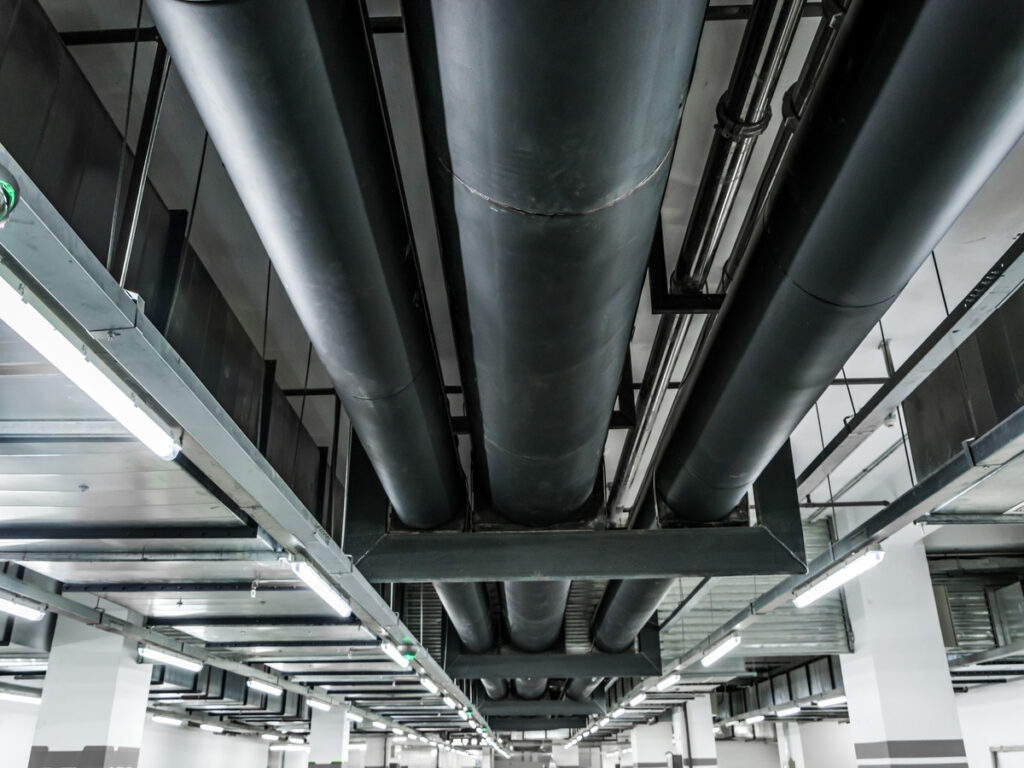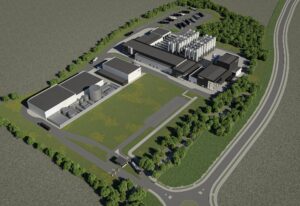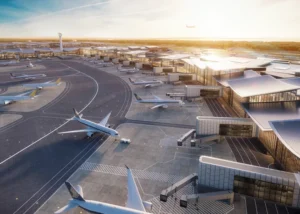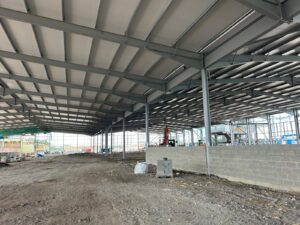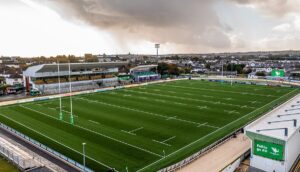Poor roof drainage poses significant risks in modern construction – from flooding and structural damage to project delays and cost overruns. As buildings grow larger and weather patterns become more intense, the traditional gravity drainage systems that have served the construction industry for decades face increasing challenges.
At Capcon, we are the rainwater specialists, providing excellence in design and production of siphonic drainage solutions. We look at siphonic versus traditional drainage approaches, exploring why siphonic systems are gaining ground in large-scale commercial and infrastructure projects.
Traditional Gravity Drainage: More is Less
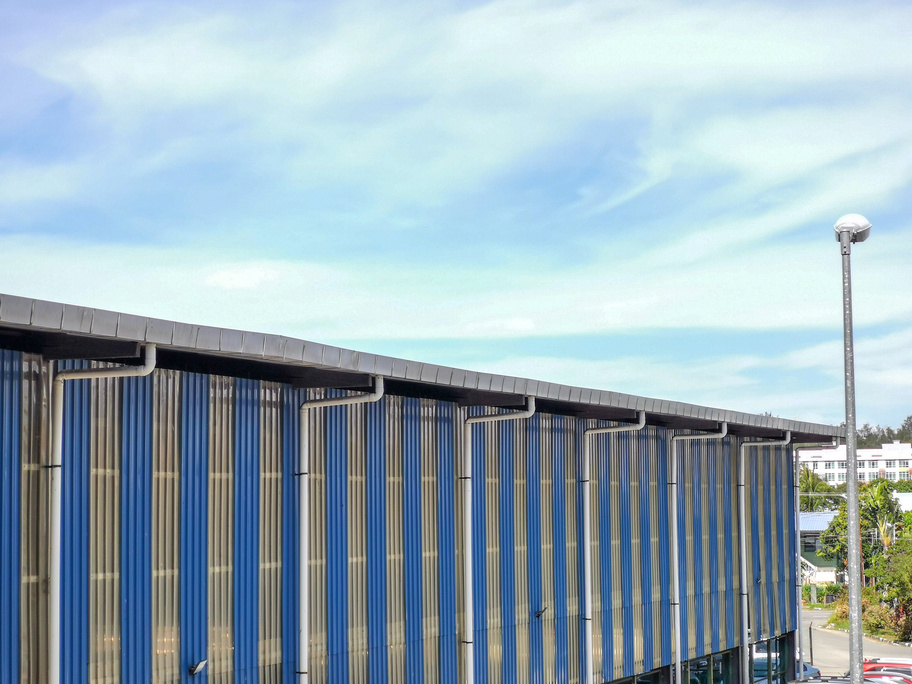
Traditional gravity drainage operates on simple principles: water flows down sloped pipes using gravity, requiring frequent vertical downpipes to manage roof rainwater runoff.
In large buildings, this approach presents several limitations:
- Multiple vertical drops consume valuable floor space
- Larger pipe diameters are needed to handle flow volumes
- Extensive underground pipework networks are required
- System capacity can be overwhelmed during extreme rainfall events
- Challenges coordinating with other services
For smaller buildings with modest roof areas and minimal architectural constraints, gravity drainage remains a practical solution. However, the demands of modern construction increasingly expose its limitations.
Siphonic Drainage: Modern Engineering in Action
Siphonic drainage systems utilise induced negative pressure to create full-bore flow, actively pulling water from roof surfaces at high velocities. The system ‘primes’ during rainfall, establishing a vacuum effect that dramatically increases flow rates.
Key components include:
- Specially designed roof outlets that prevent air entry
- Horizontal pipework that can run level without gradient
- Carefully engineered discharge points
- Precise hydraulic calculations for the entire system
- Protection from extreme weather events
Unlike gravity systems that require constant slope, siphonic pipework can run horizontally, at zero falls, through ceiling voids, offering significant design flexibility. The technology requires specialised engineering knowledge – proper design ensures the system achieves and maintains siphonic action throughout operation.
Comparative Analysis: Key Differences
Pipe Requirements: Gravity drainage requires larger diameter pipework, installed at a gradient, which limits how far you can run horizontally, which leads to considerably more pipework being needed for a gravity rainwater system than a siphonic system. As siphonic systems eliminate air from the pipework, the siphonic pipework is typically 50% smaller than the gravity equivalent, significantly assisting with the coordination process.
System Configuration: Gravity drainage typically requires numerous roof outlets and vertical drops. Siphonic systems achieve the same drainage capacity with fewer outlets strategically positioned, reducing roof penetrations and simplifying the overall design.
Flow Capacity: During intense rainfall events, siphonic systems demonstrate superior performance. The full-bore flow achieved under siphonic action can handle significantly higher volumes than traditional gravity flow in comparable pipe sizes.
Space Efficiency: The ability to run pipes horizontally, at zero falls, makes siphonic systems particularly valuable in buildings where vertical space is at a premium or where internal downpipes would compromise functional layouts.
Where Siphonic Systems Excel
From Capcon’s perspective, siphonic drainage proves most beneficial for:
Large-span roofs: Distribution centres, airports, stadiums and shopping malls with expansive roof areas benefit from reduced outlet numbers and simplified drainage networks.
Architecturally complex buildings: Projects requiring clean soffits, minimal visible services, or specific internal layouts gain flexibility from horizontal pipe routing.
Heavily Serviced Buildings: Where you have heavily serviced buildings such as Data centres and pharmaceutical buildings, siphonic drainage offers the design flexibility to simplify the coordination with other services and navigate any design challenges the project may face.
Sustainability-focused developments: Siphonic systems integrate effectively with rainwater harvesting, supporting BREEAM and LEED certification goals. The concentrated discharge points simplify collection for reuse systems.
Climate-resilient design: Buildings in areas experiencing intensifying rainfall patterns benefit from the higher flow capacities siphonic systems provide.
Addressing Common Concerns
Design Complexity: Siphonic systems do require specialised design expertise. However, established standards including BS EN 12056-3, BS 8490:2025, DIN1986-100-2016 and ASPE 45 provide clear guidance. At Capcon, we offer design support and calculations to ensure code compliance and system performance.
Initial Costs: While siphonic systems typically involve higher upfront design costs, typically the siphonic system overall should be between 20-40% more cost effective due to the reductions in outlets, pipework and interfacing trades such as groundworks, through simplified underground drainage requirements, and roofing.
Maintenance Requirements: Siphonic systems generally require less frequent maintenance due to fewer outlets and self-cleaning action from high-velocity flows. When maintenance is needed, our team of technicians are skilled and experienced to ensure the long term performance of the drainage system.
Market Adoption and Trends
According to industry analysis, the global siphonic drainage market shows robust growth, with projections indicating a compound annual growth rate of 6-8% through 2030. In the UK and Europe, siphonic systems have become mainstream for large buildings, with thousands of installations demonstrating proven performance.
The Middle East represents a high-growth market, driven by mega-projects and rapid urbanisation. Major developments increasingly specify siphonic drainage to handle occasional but intense rainfall while supporting complex architectural designs. Asia is another region seeing a similar shift, with Capcon recently appointed as the lead consultant for the siphonic roof drainage system at Singapore’s Changi Airport Terminal 5 project.
Key market drivers include:
- Climate change adaptation requirements
- Urbanisation creating larger building footprints
- Space optimisation needs in dense developments
- Green building certification requirements
- Established regulatory frameworks supporting the technology
Future Considerations
Technological advancement continues to enhance siphonic drainage capabilities:
Smart Monitoring: Integration of sensors enables real-time performance monitoring, predictive maintenance, and system optimisation.
BIM Integration: Siphonic components available as BIM objects facilitate coordination with other building services and clash detection during design.
Sustainable Integration: Combination with blue roofs, green roofs, and rainwater harvesting systems supports comprehensive water management strategies.
Advanced Materials: High-performance plastics and corrosion-resistant materials extend system lifespan and reduce maintenance requirements.
Making the Right Choice
Traditional gravity drainage maintains its place for straightforward projects with modest roof areas. However, for large-scale commercial and infrastructure projects, siphonic drainage increasingly represents the optimal solution.
The decision factors include:
- Roof area and building scale
- Architectural constraints and space requirements
- Climate resilience needs
- Sustainability objectives
- Whole-life cost considerations
- Available expertise for design and maintenance
As buildings grow larger and performance demands increase, drainage systems must evolve accordingly. Siphonic technology offers proven solutions to modern challenges, backed by established standards and decades of successful installations.
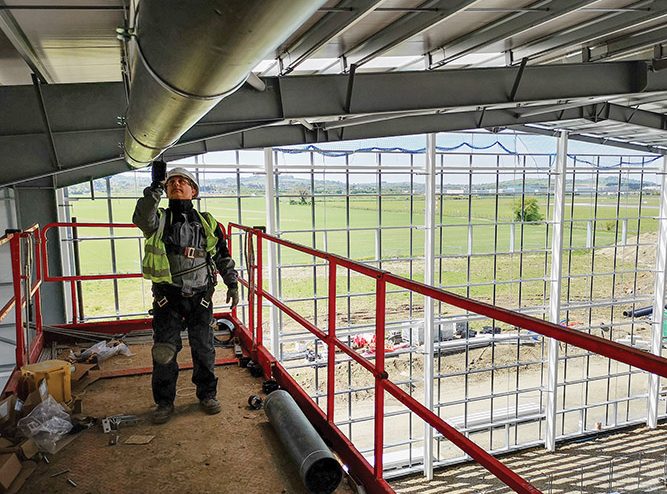
Ready to explore siphonic drainage for your project? Contact Capcon Engineering for project-specific siphonic system evaluation or CPD-accredited seminars for your design team. Let’s discuss how modern drainage solutions can benefit your next project.
Contact us today to discuss your project requirements
*Images for illustrative purposes only
How Can We Help?
Meet Donnacha Tobin
Talk to our operations director Donnacha and find out how we can tailor a solution to refurbish or upgrade your rainwater drainage system.


